The Late Show
Four experts explain why the end of the season can be the best time to hunt Canada geese, and how you can make the most of it
Four experts explain why the end of the season can be the best time to hunt Canada geese, and how you can make the most of it
The geese were already lifting off the river in town, crossing out of the city limits and flying over the cornfield that I was driving into. In the interest of time and realism, I left the decoy bases in the truck and set most of the full-bodies directly on the ground to look like birds that had flopped onto their bellies to eat. Scooping a depression in the snow for the blind, I set it up, piled loose snow up on the sides, and stuck some stubble in the straps. Then I hid the truck and rushed back to load my gun, afraid that the stream of geese flowing over my head might dry up. It didn't. The flocks kept coming, driven by the need to fuel up in the cold. I was picking up decoys an hour after I got INTO the blind.
Cold weather means hot goose hunting. Ducks Unlimited TV cohost, champion caller, and call maker Fred Zink has seen the late season turn into the best hunting of the year. "Before the advent of September nuisance hunts that force geese into town, the geese got warier as the season went on," Zink explains. "Now, they go to town early in the season and don't come out until cold weather hits. So they haven't been pressured much. When it gets cold they're almost in panic mode. They have to find new roosts and feed in unfamiliar fields. It's a total flip-flop from the way it used to be."
HERE'S HOW ZINK AND THREE OTHER EXPERT HUNTERS MEET THE LATE-SEASON CHALLENGE.
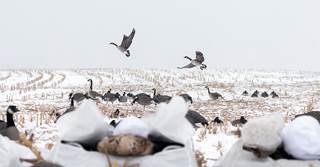
Photo Dean Pearson
Zink has hunted geese in his native Ohio and across North America for 41 years. He says 20 is the magic number. "When temperatures get below 20 degrees, geese need to eat corn to stay warm," he explains. "That's when I want to be in a cornfield near city limits and open water."
Finding the right field is the start, but you also need to pay attention to where the geese are in the field. "Geese know where the food is and where it isn't," Zink says. "If they have eaten all the food in the middle, they may be around the edges or in corners where the combines turned. You want to hunt where they are, but if you can't hide there, you can hunt a similar part of the field with better cover."
Hiding well is Zink's key to late-season success. "People don't like to talk about hiding as much as they like to talk about calling and decoys, but hiding is the most important thing," he says. Zink likes A-frame blinds because geese haven't learned to look for them yet. It's easy to hide an A-frame by tucking it into a fence line, and Zink recommends setting it up a couple of days prior to the hunt to let the geese get used to feeding around it.
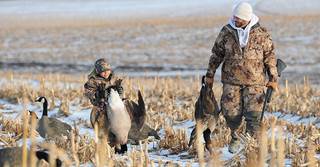
Photo Jim Thompson
When you set your spread, be conscious of the decoys' body positions. "The only reason you see geese walking in a field is because there's no food where they are, so I never set walkers within 20 yards of my blind," Zink says. "And I never set feeders more than 20 yards away." He also sets sentries facing potential danger such as rock piles or brushy fence lines, and he'll put some sentries in with the feeders, facing downwind as if warning incoming geese to stay away.
The lower the temperature, the closer you should pack the feeders together. When it's below 10 degrees, the feeders should be belly down on the ground. "Think outside the box," Zink suggests. "Most people are using five to 10 dozen decoys, but you can have a good hunt over a smaller spread, especially if you're using fully flocked decoys."
You might expect that as someone who sells thousands of calls a year, Zink would place a high importance on calling.
"I think calling ranks fourth after location, concealment, and decoys," he says. Zink sticks to feeding sounds and murmurs most of the time. Occasionally he'll simulate a fight, with two callers double-clucking and someone waving a flag to look like geese fighting over food. Like calls, flags are effective, but you have to use them realistically. "When geese are inside a quarter of a mile or maybe an eighth of a mile, I won't raise a flag higher than a decoy's back," he says. "Raising it higher just tells geese you're a hunter. You have to think less like a hunter and more like a goose."
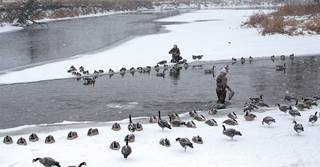
Photo Dean Pearson
One way to beat the field-hunting crowds is to hunt geese over water. John Vaca of Kansas City has been hunting waterfowl for 35 years, and he knows the value of open water late in the season. "If you've got open water, whether it's moving water or a pond you've kept open with an ice eater, you've got a scarce commodity that geese need," he says.
Unlike a roost, which can be burned out with one or two hunts, a loafing pond or a river sandbar can provide several good hunts. Once he finds a place that geese are using during the day, Vaca pays attention to what they're doing. "If they're swimming in the hole, we put floaters in the hole. If they're resting on the ice, we use sleeper shells," he says. "It's important to mimic what you see and change it up. Too many goose hunters do the same thing every time."
Hiding always matters. Vaca grasses up layout blinds and sets them along the shoreline. Like many other experienced hunters, he believes geese have learned to look for the rectangular shape of these blinds, so he'll use alternatives when he can. If there is corn stubble close by, Vaca covers up with a ghillie blanket, which eliminates the profile of a layout blind and the shadow it casts.
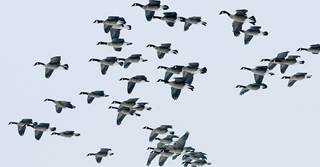
Photo Jim Thompson
Vaca says geese over water sound different. "Maybe it's just the way calling echoes over the water, but the notes are more drawn out, and they don't cluck as much when they come to water," he says. In calling, as with setting decoys, mimicking the real birds pays off. "Just because you're a great caller doesn't mean you'll be successful. I have hunted with champion callers who just want to hear themselves call. They forget we're out to hunt geese, not listen to calling." Vaca believes in letting the birds tell you what they want. "Some days you do have to call a lot, and some days you put your call away and they come in silently."
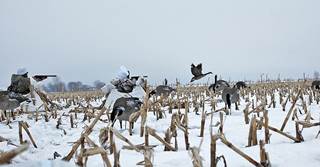
Photo Jim Thompson
M.D. Johnson shot his first goose in the 1970s in Ohio and now lives in western Washington, where he takes advantage of a special late season running into March. Johnson takes his belief in low-impact hunting to an extreme in the late season. "It takes some nerve to leave most of your decoys in the truck and use just a few, but it works. The first time I saw geese ignore my decoys and go land with a pair of live geese, I started downsizing," he says. "I've taken as few as two decoys, but more often I'll take six." If there's water in the field, as there often is in rainy western Washington, Johnson will set four floaters and two full-bodies, as geese are often more comfortable coming to water.
"With a very small spread you not only have to be in the right field, but in the right part of the field," Johnson cautions. "Also, I can get away with just a few decoys because I am not trying to hide a large group of hunters. I usually go by myself or with one or two people." He says decoy placement matters. "Geese are gregarious. They want to land with other geese, but a lot of times they will land off to one side. And what one bunch does, all the rest will do. I don't hesitate to move my decoys to make birds land where I want them to."
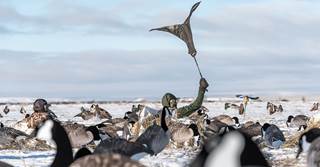
Photo Michael Clingman
Johnson places a lot of importance on concealment. He will back his blind up against a clump of bunchgrass, and he always brings a saw to cut more vegetation. He picks up shells and wads in the field and keeps all his gear inside the blind.
In keeping with his low-key approach, Johnson keeps calling and flagging to a minimum. "I have watched these birds on the ground, and they don't move or call much. I sometimes do a greeting call or make a little ground noise for realism, and that's about it."
"I love this time of year, but you have to be patient," Johnson says. "The birds can be unpredictable. I bring coffee and a lunch and make sure I stay through early afternoon. The middle of the day is often the best time."

Photo Craig Bihrle
Mike Bard guides hunters near his home in Jordan, New York, between Lake Ontario and the Finger Lakes. In this area, there is plenty of open water to hold geese when it turns cold. "It seems like when there is snow on the ground, the season resets," Bard says. "Geese lose some of their wariness."
Most of Bard's hunts involve big decoy spreads and running traffic. "We can't always be on the X, but we usually can get on the flight line," he says. Bard's ideal traffic field is elevated, both for visibility and because geese seek hilltops where the wind clears enough snow to let them get at the waste grain in the field. "I like to be at least a half mile to a mile away from the water," he says, "or the first shots will spook the geese on the water."
Traffic hunting is a numbers game when it comes to decoys. Bard routinely sets out 20 dozen to 30 dozen silhouettes, which he has come to prefer in late season over full-bodies and shells because he doesn't have to brush snow off their backs. When setting silhouettes he makes sure to set pairs at right angles. "That way, it gives the illusion of movement," he says. "I do think, though, that it takes two silhouettes to equal one full-body, because all the decoys aren't visible from every angle."
Bard packs feeders tightly around the spot where he wants geese to land. "We set them close, like a snow goose spread, where you have trouble walking between decoys. I like to put a few full-body walkers around the hole to show geese the most realistic decoys and to look like geese that have just landed and are walking in to feed."
A-frame blinds are Bard's preferred hide. "They are more comfortable and easier to shoot out of," he says. "Even if we have a small group I'll use three together. They seem to work better when they look like a bigger object in the field."
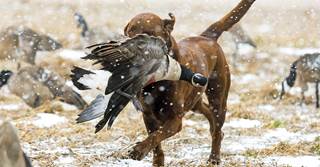
Photo RICKADAIR.COM
Movement attracts geese from a distance, and if two people in Bard's party are calling, four are waving flags. "When geese are far away, we'll use all four flags at once. As they get closer, we might alternate, with one flagger putting the flag up, waving it three or four times, and pulling it down. When geese are close we'll keep the flags low and only flag birds on the corners," he says.
Every day is different in terms of not only how much calling the geese want to hear but also in the way the calling sounds. "Late in the season calling can be muffled by snow and trees," Bard says. "Sometimes we'll have someone get out of the blind and call from 100 yards away to hear what the geese are hearing.
Ducks Unlimited uses cookies to enhance your browsing experience, optimize site functionality, analyze traffic, and deliver personalized advertising through third parties. By continuing to use this site, you agree to our use of cookies. View Privacy Policy